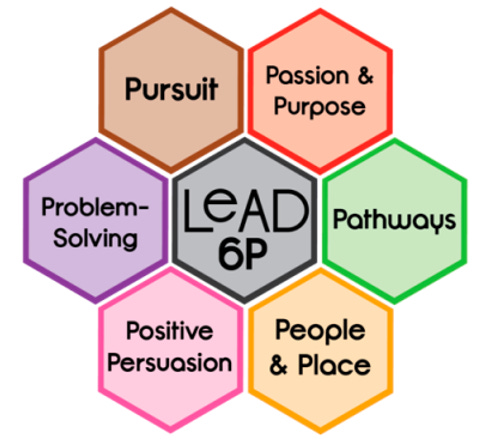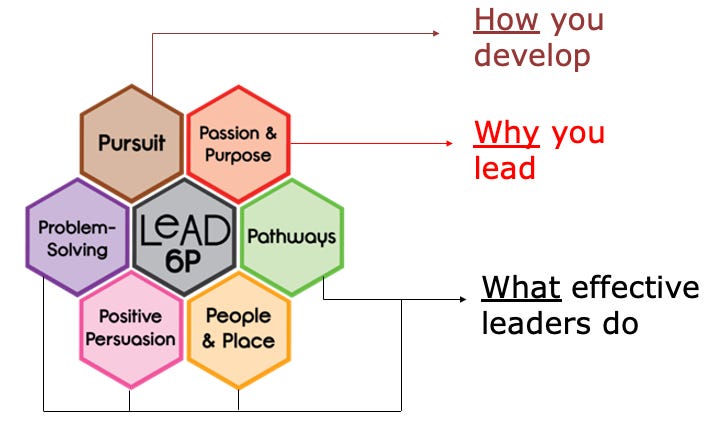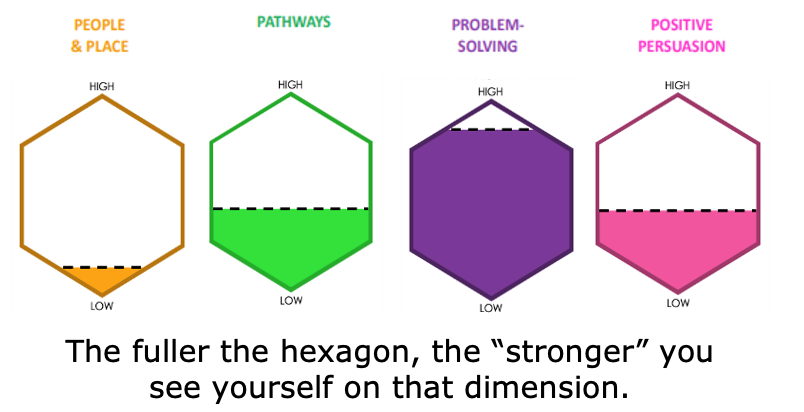In theory, if good things always come in threes, then really GREAT stuff must come in sixes. But, maybe we’re biased! After all, we did come up with The 6PLeadership Framework.
Okay, we’re definitely biased.
So, we thought it was time to brush up on and break down the 6 P’s that comprise the foundation of our evidence-based assessments (That anyone can take!) and approach to coaching, workshops, and evaluations.
An Overview
Passion & Purpose refers to awareness of your individual values, motivations, and goals—knowing why YOU lead is a first step to inspiring others.
People & Place describes the way leaders create a positive context for their teams by forming open, supportive relationships with others, supporting individual needs, and proactively sharing their appreciation.
Pathways is all about execution. The key here is creating structure, setting performance expectations, clarifying goals and roles, allocating resources, identifying obstacles, and tracking progress.
Positive Persuasion is about influencing and motivating others through positive means such as inspiration, rational reasoning, consultation of their expertise, and collaboration. Taking a positive persuasion approach to leadership enhances effectiveness and commitment, compared to other tactics like pressure or ingratiation.
Problem-Solving is about strategy and decision-making, including a leader’s skill in gathering relevant information, critical thinking, innovation, and keeping a balanced perspective. Taking more time to define ‘the problem’ sets effective problem-solvers apart from those who make quick decisions.
Pursuit describes the way a leader thinks about their own development—such as their degree of openness to feedback and strategies for monitoring and evaluating developmental progress. It's up to each individual to drive their development as a leader in the direction that they need and pursuit is how you get there!
If you want a visualization, don’t worry; we have one of those too.
Really, it breaks down like this:
So, let’s dig in a little deeper with each dimension.
Why You Lead
Why a person is called to lead is what ultimately drives their behavior and how they develop and grow as a leader over time. Once a leader understands what motivates them and gives meaning, they can begin to adjust their behavior to lead from this place.
Passion & Purpose reflects your internal values and the intrinsic interests that drive your leadership. Passion & Purpose includes the extent to which you see yourself as a leader and how that integrates with your sense of meaning in life and work. Leaders with strong passion and purpose have a desire to make a difference in the world. It should show up as a strong leader identity view (being able to confidently describe oneself as a leader), enthusiasm in a role, and pride for the work. It’s important to understand your purpose. It will act as a north star to follow, making it easier to sustain leadership over time and communicate your vision to followers. Because, as Simon Sinek preached in his iconic TED Talk, people don’t buy what you do, they buy why you do it.
What Effective Leaders Do
Once someone understands the why behind their leadership, they can begin to implement the what. When we think about what makes an effective leader, it’s all about showing, not telling. How a leader behaves both in front of followers and behind closed doors is what matters most. People and Place, Pathways, Problem Solving, and Positive Persuasion are all areas that describe ways in which a leader can be stronger or weaker in their leadership behavior.
People and Place incorporate leader behavior that builds the open and supportive relationships necessary to create a healthy work environment. Effective leaders in this dimension will display personal concern and regard for others as people, not just as workers. They’re also great at setting positive contexts that allow followers autonomy and responsibility for initiative, decisions, and action. Effective leaders excel at relational transparency, meaning they present their authentic selves to others, and share information openly so that others can feel they can be open in return.
The Pathways dimension is the embodiment of execution. The key is creating structure, like setting performance expectations, clarifying goals and roles, allocating resources, identifying obstacles, and tracking progress. Clarifying roles and objectives refer to setting clear expectations and responsibilities for team members. Effective leaders who are strong in this dimension are able to define the path to success by making order out of chaos, communicating the team’s direction, setting goals, and creating systems to support progress and goal attainment.
Problem-Solving emphasizes the actions needed to effectively create strategies and solutions to challenges faced. It requires effective decision-making, including critical thinking, innovation, and keeping a balanced perspective. Leaders high on logical reasoning tend to approach problems in a logical and clear manner. Their approach is systematic and analytical and, importantly, they communicate their thinking process to their team.
A strong problem solver is also thoughtful, seeking out opposing views, and not afraid to challenge their unquestioned assumptions. Critically, they seek out information in order to accurately define the root cause of the problem to guide their decision-making. And, though it might not seem like it falls into this bucket, strong problem solvers are actually really creative leaders who come up with fresh, new ways to improve performance and achieve objectives.
Positive Persuasion is about the strategies and approaches leaders enact to influence others. Leaders who excel here are comfortable using a form of persuasion that emphasizes ideals and values. Instead of going at it alone, leaders who score high in this dimension act collaboratively, getting others on board to gain support for their initiatives. Positive strategies of influence such as inspirational appeal, rational approach, consultation, and collaboration are more effective at not only persuading followers to align with a leader but also enhancing their commitment to the leader and the team’s goals.
How You Develop
Once you have your “why you lead,” and “what you do as a leader,” it’s time to understand “how you can develop” your leadership. How you develop is all about enhancing your capacity and drive for leadership development. Notice we didn’t say, your natural ability to lead. The research indicates that only 30% of our leadership is written in our genetic code. While some have an innate inclination towards leadership behavior, it’s absolutely a skill that can be developed by anyone.
Pursuit captures this by highlighting critical traits and behaviors that drive self-development. It reflects your desire and motivation to continuously learn and emphasizes the psychological resources and support needed to feel capable of developing as you work through leadership challenges. Leaders with pursuit recognize that development provides an enduring sense of direction and they take ownership over their path towards becoming the leader they seek to be.
The 6P Framework In Action
Once you understand why you lead, what you do as a leader, and how you should be developing, it’s time to put this framework into action. To use this framework, think of your leadership development goals as the center hexagon. Ultimately, you contain all of these dimensions. But the degree to which these present as strengths or areas for potential vary based on the individual.
Think of it kind of like love languages. Even if you enjoy the experience of gifting, it might not rank at the top of all the ways you prefer to give and receive love.
When pursuing leadership development, your primary goal should be to focus on the strengths you uncovered from your assessment. Find ways to maximize those strengths even further, while also identifying ways to leverage them to compensate for weaker areas––rather than spending energy on trying to turn a weakness into a strength. This work will ultimately help you lead from a place of your recognized passion and purpose.
So, first, determine your developmental needs. What leader behavior/skill do you need/want to get better at? If you’ve taken the LeADself or LeAD360 assessments, then you’ll be able to see your strengths and areas for improvement. Take the time to examine patterns. And, don’t forget to investigate your strengths! Focusing on what you do well will help you understand how to improve upon weaknesses.
If you’re having trouble, phone a friend. Discuss with a mentee or mentor what your leadership looks like in action. Or, better yet, hire a leadership coach!
There are plenty of approaches on how to develop or improve your leadership skills. Trust us, we’ve seen the leadership section at Barnes & Noble. It’s not lacking. But, we strongly prefer the six dimensions of effective leadership–– Passion & Purpose, People & Place, Pathways, Problem Solving, Positive Persuasion, and Pursuit––because they’re evidence-based and rooted in social science research.
Also, we advocate for it because it was designed for EVERYONE. We believe leadership development is accessible for all aspiring and emerging leaders––at any age and stage of their career––and this is a framework for just that.














Funny story...when Kim Perkins and I were developing the '6Ps' we almost went with the '4Ds' -- and I can't remember what those D-words were at all now. Ultimately, we ended up with Ps because we couldn't think of another D-word to capture 'Passion and Purpose' which was an area that we felt was critical to push the field forward. Anyone else remember the D-words? Oh one was Decision-Making (in lieu of Problem-Solving)...yeah, that's all I got! haha